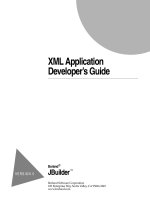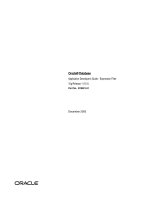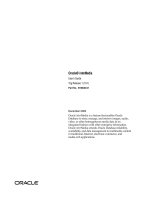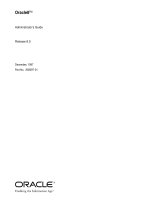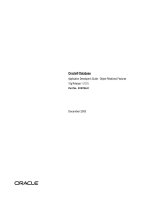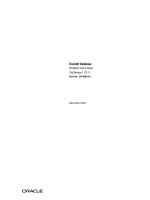Tài liệu Application Developer’s Guide - Object-Relational Features docx
Bạn đang xem bản rút gọn của tài liệu. Xem và tải ngay bản đầy đủ của tài liệu tại đây (2.4 MB, 252 trang )
Oracle® Database
Application Developer’s Guide - Object-Relational Features
10g Release 1 (10.1)
Part No. B10799-01
December 2003
Oracle Database Application Developer's Guide - Object-Relational Features, 10g Release 1 (10.1)
Part No. B10799-01
Copyright © 1996, 2003 Oracle Corporation. All rights reserved.
Contributors: Geeta Arora, Eric Belden, Chandrasekharan Iyer, Geoff Lee, Anand Manikutty, Valarie
Moore, Magdi Morsi, Helen Yeh, Adiel Yoaz, Qin Yu
The Programs (which include both the software and documentation) contain proprietary information of
Oracle Corporation; they are provided under a license agreement containing restrictions on use and
disclosure and are also protected by copyright, patent and other intellectual and industrial property
laws. Reverse engineering, disassembly or decompilation of the Programs, except to the extent required
to obtain interoperability with other independently created software or as specified by law, is prohibited.
The information contained in this document is subject to change without notice. If you find any problems
in the documentation, please report them to us in writing. Oracle Corporation does not warrant that this
document is error-free. Except as may be expressly permitted in your license agreement for these
Programs, no part of these Programs may be reproduced or transmitted in any form or by any means,
electronic or mechanical, for any purpose, without the express written permission of Oracle Corporation.
If the Programs are delivered to the U.S. Government or anyone licensing or using the programs on
behalf of the U.S. Government, the following notice is applicable:
Restricted Rights Notice Programs delivered subject to the DOD FAR Supplement are "commercial
computer software" and use, duplication, and disclosure of the Programs, including documentation,
shall be subject to the licensing restrictions set forth in the applicable Oracle license agreement.
Otherwise, Programs delivered subject to the Federal Acquisition Regulations are "restricted computer
software" and use, duplication, and disclosure of the Programs shall be subject to the restrictions in FAR
52.227-19, Commercial Computer Software - Restricted Rights (June, 1987). Oracle Corporation, 500
Oracle Parkway, Redwood City, CA 94065.
The Programs are not intended for use in any nuclear, aviation, mass transit, medical, or other inherently
dangerous applications. It shall be the licensee's responsibility to take all appropriate fail-safe, backup,
redundancy, and other measures to ensure the safe use of such applications if the Programs are used for
such purposes, and Oracle Corporation disclaims liability for any damages caused by such use of the
Programs.
Oracle is a registered trademark, and Oracle9i, Oracle Store, PL/SQL, Pro*C, Pro*C/C++, and SQL*Plus
are trademarks or registered trademarks of Oracle Corporation. Other names may be trademarks of their
respective owners.
iii
Contents
Send Us Your Comments
................................................................................................................ xiii
Preface
........................................................................................................................................................... xv
Audience ............................................................................................................................................... xvi
Organization......................................................................................................................................... xvi
Related Documentation ..................................................................................................................... xvii
Conventions........................................................................................................................................ xviii
Documentation Accessibility ............................................................................................................. xxi
What's New in Object-Relational Features?
....................................................................... xxiii
Oracle 10g Release 1 (10.1) New in Object-Relational Features.................................................. xxiv
Oracle9i Release 2 (9.2) New in Object-Relational Features........................................................ xxiv
Oracle9i Release 1 (9.0.1) New in Object-Relational Features...................................................... xxv
1 Introduction to Oracle Objects
About Oracle Objects......................................................................................................................... 1-2
Advantages of Objects....................................................................................................................... 1-2
Key Features of the Object-Relational Model............................................................................... 1-3
Core Database Key Features ....................................................................................................... 1-4
Object Types........................................................................................................................... 1-4
Objects..................................................................................................................................... 1-5
Object Methods...................................................................................................................... 1-6
Type Inheritance.................................................................................................................... 1-7
Type Evolution ...................................................................................................................... 1-7
iv
Object Tables .......................................................................................................................... 1-8
Row Objects and Column Objects....................................................................................... 1-9
Object Views........................................................................................................................... 1-9
References............................................................................................................................... 1-9
Collections ............................................................................................................................ 1-12
Language Binding Features....................................................................................................... 1-13
2 Basic Components of Oracle Objects
SQL Object Types and References ................................................................................................. 2-2
Null Objects and Attributes ........................................................................................................ 2-2
Character Length Semantics ....................................................................................................... 2-3
Constraints for Object Tables...................................................................................................... 2-4
Indexes for Object Tables............................................................................................................. 2-5
Triggers for Object Tables............................................................................................................ 2-5
Rules for REF Columns and Attributes..................................................................................... 2-6
Name Resolution .......................................................................................................................... 2-6
When Table Aliases Are Required ...................................................................................... 2-7
Restriction on Using User-Defined Types with a Remote Database..................................... 2-8
Object Methods................................................................................................................................... 2-8
Member Methods.......................................................................................................................... 2-9
Methods for Comparing Objects .............................................................................................. 2-10
Map Methods ....................................................................................................................... 2-10
Order Methods..................................................................................................................... 2-12
Guidelines for Comparison Methods ............................................................................... 2-13
Comparison Methods in Type Hierarchies...................................................................... 2-13
Static Methods............................................................................................................................. 2-13
Constructor Methods ................................................................................................................. 2-14
External Implemented Methods............................................................................................... 2-15
Inheritance in SQL Object Types................................................................................................... 2-15
Types and Subtypes.................................................................................................................... 2-15
FINAL and NOT FINAL Types and Methods........................................................................ 2-17
Creating Subtypes....................................................................................................................... 2-18
NOT INSTANTIABLE Types and Methods ........................................................................... 2-19
Inheriting, Overloading, and Overriding Methods............................................................... 2-20
Overloading Methods......................................................................................................... 2-21
v
Redefining Methods............................................................................................................ 2-21
Restrictions on Overriding Methods ................................................................................ 2-22
Dynamic Method Dispatch ....................................................................................................... 2-23
Substituting Types in a Type Hierarchy ................................................................................. 2-24
Column and Row Substitutability............................................................................................ 2-25
Using OBJECT_VALUE and OBJECT_ID with Substitutable Rows............................ 2-26
Subtypes Having Supertype Attributes........................................................................... 2-27
REF Columns and Attributes............................................................................................. 2-28
Collection Elements............................................................................................................. 2-28
Creating Subtypes After Creating Substitutable Columns................................................... 2-28
Dropping Subtypes After Creating Substitutable Columns................................................. 2-29
Turning Off Substitutability in a New Table.......................................................................... 2-29
Constraining Substitutability.................................................................................................... 2-30
Modifying Substitutability ........................................................................................................ 2-31
Restrictions on Modifying Substitutability............................................................................. 2-31
Assignments Across Types ....................................................................................................... 2-32
Objects and REFs to Objects............................................................................................... 2-32
Collection Assignments...................................................................................................... 2-34
Comparisons of Objects, REF Variables, and Collections..................................................... 2-34
Comparing Object Instances.............................................................................................. 2-34
Comparing REF Variables.................................................................................................. 2-35
Functions and Operators Useful with Objects............................................................................ 2-35
CAST............................................................................................................................................. 2-35
CURSOR....................................................................................................................................... 2-36
DEREF .......................................................................................................................................... 2-36
IS OF type .................................................................................................................................... 2-36
REF................................................................................................................................................ 2-38
SYS_TYPEID................................................................................................................................ 2-38
TABLE()........................................................................................................................................ 2-39
TREAT.......................................................................................................................................... 2-39
VALUE ......................................................................................................................................... 2-41
3 Support for Collection Datatypes
Creating Collection Datatypes ......................................................................................................... 3-2
Creating an Instance of a VARRAY or Nested Table.............................................................. 3-2
vi
Constructor Methods for Collections......................................................................................... 3-2
Varrays ........................................................................................................................................... 3-3
Nested Tables ................................................................................................................................ 3-4
Specifying a Tablespace When Storing a Nested Table .......................................................... 3-6
Varray Storage............................................................................................................................... 3-6
Increasing the Size and Precision of VARRAYs and Nested Tables..................................... 3-7
Increasing VARRAY Limit Size.................................................................................................. 3-8
Creating a Varray Containing LOB References........................................................................ 3-8
Multilevel Collection Types ........................................................................................................ 3-9
Nested Table Storage Tables for Multilevel Collection Types........................................ 3-9
Assignment and Comparison of Multilevel Collections................................................ 3-11
Constructors for Multilevel Collections ........................................................................... 3-11
Operations on Collection Datatypes............................................................................................. 3-12
Querying Collections.................................................................................................................. 3-12
Nesting Results of Collection Queries.............................................................................. 3-12
Unnesting Results of Collection Queries ......................................................................... 3-13
Unnesting Queries Containing Table Expression Subqueries ...................................... 3-14
Unnesting Queries with Multilevel Collections.............................................................. 3-15
Performing DML Operations on Collections.......................................................................... 3-15
Performing DML on Multilevel Collections.................................................................... 3-16
Comparisons of Collections ...................................................................................................... 3-17
Equal and Not Equal Comparisons .................................................................................. 3-17
In Comparisons.................................................................................................................... 3-18
Subset of Multiset Comparison ......................................................................................... 3-18
Member of a Nested Table Comparison .......................................................................... 3-18
Empty Comparison ............................................................................................................. 3-19
Set Comparison.................................................................................................................... 3-19
Multisets Operations .................................................................................................................. 3-19
CARDINALITY.................................................................................................................... 3-19
COLLECT.............................................................................................................................. 3-20
MULTISET EXCEPT............................................................................................................ 3-20
MULTISET INTERSECTION............................................................................................. 3-20
MULTISET UNION............................................................................................................. 3-21
POWERMULTISET ............................................................................................................. 3-22
POWERMULTISET_BY_CARDINALITY........................................................................ 3-22
vii
SET......................................................................................................................................... 3-22
4 Object Support in Oracle Programming Environments
SQL........................................................................................................................................................ 4-2
PL/SQL.................................................................................................................................................. 4-2
Oracle Call Interface (OCI) ............................................................................................................... 4-2
Associative Access in OCI Programs......................................................................................... 4-3
Navigational Access in OCI Programs...................................................................................... 4-4
Object Cache.................................................................................................................................. 4-4
Building an OCI Program That Manipulates Objects ............................................................. 4-5
Defining User-Defined Constructors in C................................................................................. 4-6
Pro*C/C++ ............................................................................................................................................ 4-6
Associative Access in Pro*C/C++.............................................................................................. 4-7
Navigational Access in Pro*C/C++........................................................................................... 4-7
Converting Between Oracle Types and C Types ..................................................................... 4-8
Oracle Type Translator (OTT)..................................................................................................... 4-8
Oracle C++ Call Interface (OCCI) ................................................................................................... 4-8
OCCI Associative Relational and Object Interfaces................................................................. 4-9
The OCCI Navigational Interface............................................................................................... 4-9
Oracle Objects For OLE (OO4O) ................................................................................................... 4-10
Representing Objects in Visual Basic (OraObject) ................................................................. 4-11
Representing REFs in Visual Basic (OraRef) .......................................................................... 4-12
Representing VARRAYs and Nested Tables in Visual Basic (OraCollection)................... 4-12
Java: JDBC, Oracle SQLJ, JPublisher, and SQLJ Object Types................................................ 4-12
JDBC Access to Oracle Object Data.......................................................................................... 4-13
SQLJ Access to Oracle Object Data .......................................................................................... 4-14
Choosing a Data Mapping Strategy......................................................................................... 4-14
Using JPublisher to Create Java Classes for JDBC and SQLJ Programs............................. 4-14
What JPublisher Produces for a User-Defined Object Type ......................................... 4-15
Java Object Storage..................................................................................................................... 4-16
Representing SQLJ Types to the Server ........................................................................... 4-17
Creating SQLJ Object Types............................................................................................... 4-17
Additional Notes About Mapping.................................................................................... 4-18
Evolving SQLJ Types .......................................................................................................... 4-19
Constraints ........................................................................................................................... 4-19
viii
Querying SQLJ Objects ....................................................................................................... 4-20
Inserting Java Objects.......................................................................................................... 4-20
Updating SQLJ Objects ....................................................................................................... 4-20
Defining User-Defined Constructors in Java.......................................................................... 4-20
XML ..................................................................................................................................................... 4-21
5 Applying an Object Model to Relational Data
Why Use Object Views ...................................................................................................................... 5-2
Defining Object Views ...................................................................................................................... 5-3
Using Object Views in Applications .............................................................................................. 5-4
Nesting Objects in Object Views..................................................................................................... 5-4
Identifying Null Objects in Object Views..................................................................................... 5-6
Using Nested Tables and Varrays in Object Views...................................................................... 5-6
Single-Level Collections in Object Views.................................................................................. 5-6
Multilevel Collections in Object Views...................................................................................... 5-7
Specifying Object Identifiers for Object Views............................................................................ 5-9
Creating References to View Objects............................................................................................ 5-10
Modelling Inverse Relationships with Object Views ............................................................... 5-11
Updating Object Views ................................................................................................................... 5-12
Updating Nested Table Columns in Views ............................................................................ 5-13
Using INSTEAD OF Triggers to Control Mutating and Validation.................................... 5-13
Applying the Object Model to Remote Tables............................................................................ 5-14
Defining Complex Relationships in Object Views .................................................................... 5-15
Tables and Types to Demonstrate Circular View References .............................................. 5-16
Creating Object Views with Circular References................................................................... 5-17
Object View Hierarchies.................................................................................................................. 5-19
Creating an Object View Hierarchy ......................................................................................... 5-21
The Flat Model ..................................................................................................................... 5-21
The Horizontal Model......................................................................................................... 5-23
The Vertical Model .............................................................................................................. 5-25
Querying a View in a Hierarchy............................................................................................... 5-26
Privileges for Operations on View Hierarchies...................................................................... 5-27
6 Managing Oracle Objects
Privileges on Object Types and Their Methods............................................................................ 6-2
ix
System Privileges for Object Types............................................................................................ 6-2
Schema Object Privileges............................................................................................................. 6-2
Using Types in New Types or Tables........................................................................................ 6-3
Example: Privileges on Object Types......................................................................................... 6-3
Privileges on Type Access and Object Access .......................................................................... 6-4
Dependencies and Incomplete Types ............................................................................................ 6-5
Completing Incomplete Types .................................................................................................. 6-7
Manually Recompiling a Type.................................................................................................... 6-8
Type Dependencies of Substitutable Tables and Columns ................................................... 6-8
The FORCE Option ............................................................................................................... 6-9
Synonyms for User-Defined Types.................................................................................................. 6-9
Creating a Type Synonym........................................................................................................... 6-9
Using a Type Synonym.............................................................................................................. 6-10
Describing Schema Objects That Use Synonyms............................................................ 6-10
Dependents of Type Synonyms ........................................................................................ 6-11
Restriction on Replacing a Type Synonym...................................................................... 6-11
Dropping Type Synonyms................................................................................................. 6-11
Renaming Type Synonyms ................................................................................................ 6-12
Public Type Synonyms and Local Schema Objects ........................................................ 6-12
Performance Tuning ......................................................................................................................... 6-12
Tools Providing Support for Objects ............................................................................................ 6-13
Utilities Providing Support for Objects....................................................................................... 6-14
7 Advanced Topics for Oracle Objects
Storage of Objects............................................................................................................................... 7-2
Leaf-Level Attributes .................................................................................................................. 7-2
How Row Objects Are Split Across Columns .......................................................................... 7-2
Hidden Columns for Tables with Column Objects ................................................................. 7-2
Hidden Columns for Substitutable Columns and Tables....................................................... 7-3
REFs................................................................................................................................................ 7-4
Internal Layout of Nested Tables............................................................................................... 7-4
Internal Layout of VARRAYs ..................................................................................................... 7-5
Creating Indexes on Typeids or Attributes.................................................................................... 7-5
Indexing a Type Discriminant Column..................................................................................... 7-5
Indexing Subtype Attributes of a Substitutable Column........................................................ 7-6
x
Type Evolution..................................................................................................................................... 7-7
Changes Involved When a Type Is Altered.............................................................................. 7-9
Steps to Change a Type.............................................................................................................. 7-10
Validating a Type........................................................................................................................ 7-11
If a Type Change Validation Fails ............................................................................................ 7-15
ALTER TYPE Statement for Type Evolution.......................................................................... 7-15
ALTER TABLE Statement for Type Evolution....................................................................... 7-19
The Attribute-Value Constructor ............................................................................................. 7-19
Constructors and Type Evolution ............................................................................................ 7-19
Advantages of User-Defined Constructors............................................................................. 7-20
Defining and Implementing User-Defined Constructors ..................................................... 7-20
Overloading and Hiding Constructors.................................................................................... 7-22
Calling User-Defined Constructors.......................................................................................... 7-22
Constructors for SQLJ Object Types ........................................................................................ 7-24
Transient and Generic Types .......................................................................................................... 7-25
User-Defined Aggregate Functions ............................................................................................... 7-28
Partitioning Tables That Contain Oracle Objects ...................................................................... 7-29
How Locators Improve the Performance of Nested Tables ................................................. 7-30
8 Design Considerations for Oracle Objects
General Storage Considerations for Objects................................................................................. 8-2
Storing Objects as Columns or Rows......................................................................................... 8-2
Column Object Storage......................................................................................................... 8-2
Row Object Storage in Object Tables .................................................................................. 8-5
Storage Considerations for Object Identifiers (OIDs).............................................................. 8-6
Primary-Key Based OIDs ..................................................................................................... 8-6
Performance of Object Comparisons .............................................................................................. 8-7
Design Considerations for REFs...................................................................................................... 8-8
Storage Size of REFs ..................................................................................................................... 8-8
Integrity Constraints for REF Columns..................................................................................... 8-8
Performance and Storage Considerations for Scoped REFs................................................... 8-9
Indexing Scoped REFs .......................................................................................................... 8-9
Speeding up Object Access Using the WITH ROWID Option............................................. 8-10
Design Considerations for Collections......................................................................................... 8-11
Viewing Object Data in Relational Form with Unnesting Queries ..................................... 8-11
xi
Using Procedures and Functions in Unnesting Queries................................................ 8-12
Storage Considerations for Varrays......................................................................................... 8-13
Propagating VARRAY Size Change ................................................................................. 8-13
Performance of Varrays Versus Nested Tables...................................................................... 8-14
Design Considerations for Nested Tables............................................................................... 8-14
Nested Table Storage .......................................................................................................... 8-14
Nested Table Indexes.......................................................................................................... 8-17
Nested Table Locators ........................................................................................................ 8-18
Optimizing Set Membership Queries............................................................................... 8-19
Design Considerations for Multilevel Collections................................................................. 8-19
Design Considerations for Methods............................................................................................. 8-24
Choosing a Language for Method Functions ......................................................................... 8-25
Static Methods............................................................................................................................. 8-27
Using SELF IN OUT NOCOPY with Member Procedures .................................................. 8-28
Function-Based Indexes on the Return Values of Type Methods ....................................... 8-28
Writing Reusable Code Using Invoker Rights............................................................................ 8-29
Replicating Object Tables and Columns...................................................................................... 8-31
Replicating Columns of Object, Collection, or REF Type..................................................... 8-31
Replicating Object Tables .......................................................................................................... 8-32
Constraints on Objects..................................................................................................................... 8-33
Considerations Related to Type Evolution.................................................................................. 8-33
Pushing a Type Change Out to Clients ................................................................................... 8-33
Changing Default Constructors................................................................................................ 8-34
Altering the FINAL Property of a Type .................................................................................. 8-34
Parallel Queries with Oracle Objects .......................................................................................... 8-34
Design Consideration Tips and Techniques ............................................................................... 8-35
Deciding Whether to Evolve a Type or Create a Subtype Instead...................................... 8-35
How ANYDATA Differs from User-Defined Types ............................................................. 8-36
Polymorphic Views: An Alternative to an Object View Hierarchy .................................... 8-36
The SQLJ Object Type ................................................................................................................ 8-37
The Intended Use of SQLJ Object Types.......................................................................... 8-37
Actions Performed When Creating a SQLJ Object Type ............................................... 8-38
Uses of SQLJ Object Types................................................................................................. 8-38
Uses of Custom Object Types............................................................................................ 8-38
Differences Between SQLJ and Custom Object Types Through JDBC........................ 8-39
xii
Miscellaneous Tips ..................................................................................................................... 8-39
Column Substitutability and the Number of Attributes in a Hierarchy ..................... 8-39
Circular Dependencies Among Types.............................................................................. 8-40
9 A Sample Application Using Object-Relational Features
Introduction to the Sample Application......................................................................................... 9-2
Index
xiii
Send Us Your Comments
Oracle Database Application Developer's Guide - Object-Relational Features, 10g Release 1
(10.1)
Part No. B10799-01
Oracle Corporation welcomes your comments and suggestions on the quality and usefulness of this
publication. Your input is an important part of the information used for revision.
■
Did you find any errors?
■
Is the information clearly presented?
■
Do you need more information? If so, where?
■
Are the examples correct? Do you need more examples?
■
What features did you like most about this manual?
If you find any errors or have any other suggestions for improvement, please indicate the title and
part number of the documentation and the chapter, section, and page number (if available). You can
send comments to us in the following ways:
■
Electronic mail:
■
FAX: (650) 506-7227 Attn: Server Technologies Documentation Manager
■
Postal service:
Oracle Corporation
Server Technologies Documentation
500 Oracle Parkway, Mailstop 4op11
Redwood Shores, CA 94065
USA
If you would like a reply, please give your name, address, telephone number, and electronic mail
address (optional).
If you have problems with the software, please contact your local Oracle Support Services.
xiv
xv
Preface
Oracle Database Application Developer's Guide - Object-Relational Features describes
how to use the object-relational features of the Oracle Server, 10g Release 1 (10.1).
Information in this guide applies to versions of the Oracle Server that run on all
platforms, and does not include system-specific information.
This preface contains these topics:
■
Audience
■
Organization
■
Related Documentation
■
Conventions
■
Documentation Accessibility
xvi
Audience
Oracle Database Application Developer's Guide - Object-Relational Features is intended
for programmers developing new applications or converting existing applications
to run in the Oracle environment. The object-relational features are often used in
content management, data warehousing, data/information integration, and similar
applications that deal with complex structured data. The object views feature can be
valuable when writing new C++, Java, or XML applications on top of an existing
relational schema.
This guide assumes that you have a working knowledge of application
programming and that you are familiar with the use of Structured Query Language
(SQL) to access information in relational database systems.
Organization
This document contains:
Chapter 1, "Introduction to Oracle Objects"
Introduces the key features and explains the advantages of the object-relational
model.
Chapter 2, "Basic Components of Oracle Objects"
Explains the basic concepts and terminology that you need to work with Oracle
Objects.
Chapter 3, "Support for Collection Datatypes"
Discusses collection datatypes and operations on collection datatypes.
Chapter 4, "Object Support in Oracle Programming Environments"
Summarizes the object-relational features in SQL and PL/SQL; Oracle Call Interface
(OCI); Pro*C/C++; Oracle Objects For OLE; and Java, JDBC, and Oracle SQLJ. The
information in this chapter is high-level, for education and planning. The following
chapters explain how to use the object-relational features in greater detail.
Chapter 5, "Applying an Object Model to Relational Data"
Explains object views, which allow you to develop object-oriented applications
without changing the underlying relational schema.
xvii
Chapter 6, "Managing Oracle Objects"
Explains how to perform essential operations with objects and object types.
Chapter 7, "Advanced Topics for Oracle Objects"
Discusses features that you might need to manage storage and performance as you
scale up an object-oriented application.
Chapter 8, "Design Considerations for Oracle Objects"
Explains the implementation and performance characteristics of the Oracle
object-relational model.
Chapter 9, "A Sample Application Using Object-Relational Features"
Demonstrates how a relational program can be rewritten as an object-oriented one,
schema and all.
Related Documentation
For more information, see these Oracle resources:
■
PL/SQL User's Guide and Reference for information on PL/SQL, the procedural
language extension to Oracle SQL
■
Oracle Database Application Developer's Guide - Fundamentals for general
information about developing applications
■
Oracle XML DB Developer's Guide and Oracle XML Developer's Kit Programmer's
Guide for information about developing applications with XML
■
Oracle Database JDBC Developer's Guide and Reference and Oracle Database Java
Developer's Guide to use Oracle object-relational features through Java
■
Oracle Call Interface Programmer's Guide and Oracle C++ Call Interface
Programmer's Guide for information on using the Oracle Call Interface (OCI) and
Oracle C++ Call Interface to build third-generation language (3GL) applications
that access the Oracle Server
■
Pro*C/C++ Programmer's Guide for information on Oracle's Pro* series of
precompilers, which allow you to embed SQL and PL/SQL in 3GL application
programs written in Ada, C, C++, COBOL, or FORTRAN
■
Oracle Database SQL Reference and Oracle Database Administrator's Guide for
information on SQL
■
Oracle Database Concepts for information on basic Oracle concepts
xviii
Many of the books in the documentation set use the sample schemas of the seed
database, which is installed by default when you install Oracle. Refer to Oracle
Database Sample Schemas for information on how these schemas were created and
how you can use them yourself.
Printed documentation is available for sale in the Oracle Store at
/>To download free release notes, installation documentation, white papers, or other
collateral, please visit the Oracle Technology Network (OTN). You must register
online before using OTN; registration is free and can be done at
/>If you already have a username and password for OTN, then you can go directly to
the documentation section of the OTN Web site at
/>Conventions
This section describes the conventions used in the text and code examples of this
documentation set. It describes:
■
Conventions in Text
■
Conventions in Code Examples
Conventions in Text
We use various conventions in text to help you more quickly identify special terms.
The following table describes those conventions and provides examples of their use.
Convention Meaning Example
Bold Bold typeface indicates terms that are
defined in the text or terms that appear in
a glossary, or both.
When you specify this clause, you create an
index-organized table.
Italics Italic typeface indicates book titles or
emphasis.
Oracle Database Concepts
Ensure that the recovery catalog and target
database do not reside on the same disk.
xix
Conventions in Code Examples
Code examples illustrate SQL, PL/SQL, SQL*Plus, or other command-line
statements. They are displayed in a monospace (fixed-width) font and separated
from normal text as shown in this example:
SELECT username FROM DBA_USERS WHERE username = 'MIGRATE';
The following table describes typographic conventions used in code examples and
provides examples of their use.
UPPERCASE
monospace
(fixed-width)
font
Uppercase monospace typeface indicates
elements supplied by the system. Such
elements include parameters, privileges,
datatypes, RMAN keywords, SQL
keywords, SQL*Plus or utility commands,
packages and methods, as well as
system-supplied column names, database
objects and structures, usernames, and
roles.
You can specify this clause only for a NUMBER
column.
You can back up the database by using the
BACKUP command.
Query the TABLE_NAME column in the USER_
TABLES data dictionary view.
Use the DBMS_STATS.GENERATE_STATS
procedure.
lowercase
monospace
(fixed-width)
font
Lowercase monospace typeface indicates
executables, filenames, directory names,
and sample user-supplied elements. Such
elements include computer and database
names, net service names, and connect
identifiers, as well as user-supplied
database objects and structures, column
names, packages and classes, usernames
and roles, program units, and parameter
values.
Note: Some programmatic elements use a
mixture of UPPERCASE and lowercase.
Enter these elements as shown.
Enter sqlplus to open SQL*Plus.
The password is specified in the orapwd file.
Back up the datafiles and control files in the
/disk1/oracle/dbs directory.
The department_id, department_name,
and location_id columns are in the
hr.departments table.
Set the QUERY_REWRITE_ENABLED
initialization parameter to true.
Connect as oe user.
The JRepUtil class implements these
methods.
lowercase
italic
monospace
(fixed-width)
font
Lowercase italic monospace font
represents placeholders or variables.
You can specify the parallel_clause.
Run Uold_release.SQL where old_
release refers to the release you installed
prior to upgrading.
Convention Meaning Example
xx
Convention Meaning Example
[ ]
Brackets enclose one or more optional
items. Do not enter the brackets.
DECIMAL (digits [ , precision ])
{ }
Braces enclose two or more items, one of
which is required. Do not enter the
braces.
{ENABLE | DISABLE}
|
A vertical bar represents a choice of two
or more options within brackets or braces.
Enter one of the options. Do not enter the
vertical bar.
{ENABLE | DISABLE}
[COMPRESS | NOCOMPRESS]
...
Horizontal ellipsis points indicate either:
■
That we have omitted parts of the
code that are not directly related to
the example
■
That you can repeat a portion of the
code
CREATE TABLE ... AS subquery;
SELECT col1, col2, ... , coln FROM
employees;
.
.
.
Vertical ellipsis points indicate that we
have omitted several lines of code not
directly related to the example.
SQL> SELECT NAME FROM V$DATAFILE;
NAME
---------------------------------
/fsl/dbs/tbs_01.dbf
/fs1/dbs/tbs_02.dbf
.
.
.
/fsl/dbs/tbs_09.dbf
9 rows selected.
Other notation You must enter symbols other than
brackets, braces, vertical bars, and ellipsis
points as shown.
acctbal NUMBER(11,2);
acct CONSTANT NUMBER(4) := 3;
Italics Italicized text indicates placeholders or
variables for which you must supply
particular values.
CONNECT SYSTEM/system_password
DB_NAME = database_name
UPPERCASE Uppercase typeface indicates elements
supplied by the system. We show these
terms in uppercase in order to distinguish
them from terms you define. Unless terms
appear in brackets, enter them in the
order and with the spelling shown.
However, because these terms are not
case sensitive, you can enter them in
lowercase.
SELECT last_name, employee_id FROM
employees;
SELECT * FROM USER_TABLES;
DROP TABLE hr.employees;
xxi
Documentation Accessibility
Our goal is to make Oracle products, services, and supporting documentation
accessible, with good usability, to the disabled community. To that end, our
documentation includes features that make information available to users of
assistive technology. This documentation is available in HTML format, and contains
markup to facilitate access by the disabled community. Standards will continue to
evolve over time, and Oracle is actively engaged with other market-leading
technology vendors to address technical obstacles so that our documentation can be
accessible to all of our customers. For additional information, visit the Oracle
Accessibility Program Web site at
/>Accessibility of Code Examples in Documentation
JAWS, a Windows screen
reader, may not always correctly read the code examples in this document. The
conventions for writing code require that closing braces should appear on an
otherwise empty line; however, JAWS may not always read a line of text that
consists solely of a bracket or brace.
Accessibility of Links to External Web Sites in Documentation
This
documentation may contain links to Web sites of other companies or organizations
that Oracle does not own or control. Oracle neither evaluates nor makes any
representations regarding the accessibility of these Web sites.
lowercase Lowercase typeface indicates
programmatic elements that you supply.
For example, lowercase indicates names
of tables, columns, or files.
Note: Some programmatic elements use a
mixture of UPPERCASE and lowercase.
Enter these elements as shown.
SELECT last_name, employee_id FROM
employees;
sqlplus hr/hr
CREATE USER mjones IDENTIFIED BY ty3MU9;
Convention Meaning Example
xxii
xxiii
What's New in Object-Relational Features?
This section describes the new object-relational features of Oracle 10g Release 1
(10.1). New features information from previous releases is also retained to help
those users upgrading to the current release.
The following sections describe the new features in Oracle object-relational features:
■
Oracle 10g Release 1 (10.1) New in Object-Relational Features
■
Oracle9i Release 2 (9.2) New in Object-Relational Features
■
Oracle9i Release 1 (9.0.1) New in Object-Relational Features
xxiv
Oracle 10g Release 1 (10.1) New in Object-Relational Features
New object-relational features for Oracle 10g Release 1 (10.1) include the following
collection enhancements:
■
New functionality for nested table and varray storage, including the evolution
of varray size and specification of a tablespace when storing nested tables. See
"Creating Collection Datatypes" on page 3-2.
■
New functionality for nested table comparisons and ANSI SQL multiset
operations for nested tables. See "Operations on Collection Datatypes" on
page 3-12.
Oracle9i Release 2 (9.2) New in Object-Relational Features
New object-relational features for Oracle9i release 2 (9.2) include:
■
Character length semantics
Lengths for character types CHAR and VARCHAR2 may be specified as a number
of characters, instead of bytes, in object attributes and collections even if some
of the characters consist of multiple bytes. See "Character Length Semantics" on
page 2-3.
■
Modifying substitutability
In an existing table, you can change the substitutability of an object column by
using an ALTER TABLE statement with the [NOT] SUBSTITUTABLE AT ALL
LEVELS clause. See "Modifying Substitutability" on page 2-31.
■
Type synonyms
Synonyms can be defined for user-defined types so that a type can be used
without having to qualify its name with the name of the schema in which the
type was defined. See "Synonyms for User-Defined Types" on page 6-9.
■
User-defined constructors
User-defined constructor functions make possible custom initialization of newly
created object instances. They also make it possible to evolve a type without
having to update calls to constructors in existing code to accommodate a newly
added attribute. See "Advantages of User-Defined Constructors" on page 7-20.
xxv
Oracle9i Release 1 (9.0.1) New in Object-Relational Features
New object-relational features for Oracle9i release 1 (9.0.1) include:
■
SQL type inheritance
User-defined types can be specialized as subtypes in a SQL type hierarchy. See
"Inheritance in SQL Object Types" on page 2-15.
■
Object view hierarchies
Hierarchies can be created of object views based on some or all of the types in a
type hierarchy. Object view hierarchies simplify targeting a particular subtype
(and perhaps its subtypes) in queries and other operations. See "Object View
Hierarchies" on page 5-19.
■
Type evolution
User-defined SQL types and their independent objects can be changed, or
evolved, instead of having to be re-created. See "Type Evolution" on page 7-7.
■
User-defined aggregate functions
Custom aggregate functions can be defined for working with complex data. See
"User-Defined Aggregate Functions" on page 7-28.
■
Generic and transient datatypes
External procedures can be given fields or parameters of a generic type, such as
SYS.ANYTYPE, that can contain values of any scalar or user-defined type,
making it unnecessary to implement multiple versions of the same external
procedure just to handle multiple datatypes. See "Transient and Generic Types"
on page 7-25.
■
Function-based indexes
Function-based indexes can be built on type method functions. See
"Function-Based Indexes on the Return Values of Type Methods" on page 8-28.
■
Multilevel collections
Collections (varrays and nested tables) can contain elements that are themselves
collections or have attributes that are. See Chapter 3, "Support for Collection
Datatypes" and Chapter 5, "Applying an Object Model to Relational Data".
■
C++ interface to Oracle
A C++ interface (OCCI) to Oracle, built on top of OCI, enables you to use the
object-oriented features, native classes, and methods of the C++ programing
